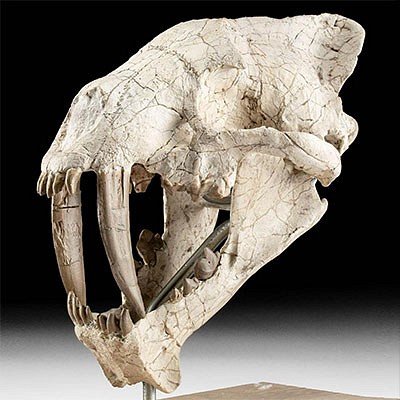20th C. Indonesian Wood & Horn Buffalo
Lot 58
About Seller
Artemis Gallery
686 S Taylor Ave, Ste 106
Louisville, CO 80027
United States
Selling antiquities, ancient and ethnographic art online since 1993, Artemis Gallery specializes in Classical Antiquities (Egyptian, Greek, Roman, Near Eastern), Asian, Pre-Columbian, African / Tribal / Oceanographic art. Our extensive inventory includes pottery, stone, metal, wood, glass and textil...Read more
Estimate:
$4,500 - $6,750
Absentee vs Live bid
Two ways to bid:
- Leave a max absentee bid and the platform will bid on your behalf up to your maximum bid during the live auction.
- Bid live during the auction and your bids will be submitted real-time to the auctioneer.
Bid Increments
| Price | Bid Increment |
|---|---|
| $0 | $25 |
| $300 | $50 |
| $1,000 | $100 |
| $2,000 | $250 |
| $5,000 | $500 |
| $10,000 | $1,000 |
| $20,000 | $2,500 |
| $50,000 | $5,000 |
| $100,000 | $10,000 |
| $200,000 | $20,000 |
About Auction
By Artemis Gallery
Jul 13, 2021
Set Reminder
2021-07-13 12:00:00
2021-07-13 12:00:00
America/New_York
Bidsquare
Bidsquare : Fauna, Flora, Stones & Bones
https://www.bidsquare.com/auctions/artemis-gallery/fauna-flora-stones-bones-7214
Join us for a very special summer auction featuring fabulous fossils, rocks, and minerals, plus art depicting flora and fauna from antiquity to present day. This is one you won't want to miss! Artemis Gallery info@artemisgallery.com
Join us for a very special summer auction featuring fabulous fossils, rocks, and minerals, plus art depicting flora and fauna from antiquity to present day. This is one you won't want to miss! Artemis Gallery info@artemisgallery.com
- Lot Description
Southeast Asia, Indonesia, Sulawesi Island, Toraja people, ca. 1960s CE. A magnificent and sizable carved-wood sculpture of a water buffalo known as a kabongo. Standing upon its two front legs, the massive beast displays a colossal head with annular eyes, a square snout, incised nostrils, and a straight mouth adorned with a circular motif, all flanked by two dramatically swooping horns from a real buffalo. The creature's thick body features a large hump, which is characteristic of the animal, and liberal remains of black pigment. Examples like this impressive sculpture are used to decorate the facade of a Toraja ancestral house called a tongkonan and indicate that one of the highest forms of funeral rites has been performed there for an elite member of the house. Water buffaloes are central to the culture of the Toraja peoples; not only do they serve as currency and symbols of status and wealth, but tongkonan houses, with their curved and extended rooves, are said to have been modelled after the form of the buffalo. The brutish beasts are also traditionally sacrificed as part of Torajan funerary rites, as they are believed to help the deceased on their journey to the afterlife. The more powerful a person, the more buffalo will be sacrificed at their funeral. Size: 35" L x 38.5" W x 18.5" H (88.9 cm x 97.8 cm x 47 cm); 20.5" H (52.1 cm) on included custom stand.
The Toraja are one of the oldest ethnic groups in all of Indonesia, though they did not view themselves as an ethnic group until the early 20th century. The Dutch colonial government named the people "Toraja" in 1909 as a means of identifying which ethnic groups they controlled during the period of Dutch colonization. The word "Toraja" comes from the Bugis Buginese language term "to riaja," meaning "people of the uplands." Torajans are renowned for their elaborate funeral rites, burial sites carved into rocky cliffs, tongkonans, and colorful wood carvings.
This piece has been searched against the Art Loss Register database and has been cleared. The Art Loss Register maintains the world’s largest database of stolen art, collectibles, and antiques.
Provenance: private Houston, Texas, USA collection, acquired in 2006; ex-James Baker, Santa Fe, New Mexico, USA
All items legal to buy/sell under U.S. Statute covering cultural patrimony Code 2600, CHAPTER 14, and are guaranteed to be as described or your money back.
A Certificate of Authenticity will accompany all winning bids.
PLEASE NOTE: Due to recent increases of shipments being seized by Australian & German customs (even for items with pre-UNESCO provenance), we will no longer ship most antiquities and ancient Chinese art to Australia & Germany. For categories of items that are acceptable to ship to Australia, please contact us directly or work with your local customs brokerage firm.
#162918Proper left horn and left leg can be detached. Chip to right foot and nose. Stable fissures to wood, as well as expected nicks/chips, scratches, and abrasions. Light wrinkling to bases of horns. Otherwise, very nice with liberal remains of pigment.Condition
- Shipping Info
-
All shipping is handled in-house for your convenience. Your invoice from Artemis Gallery will include shipping calculation instructions. If in doubt, please inquire BEFORE bidding for estimated shipping costs for individual items.
-
- Buyer's Premium



 EUR
EUR CAD
CAD AUD
AUD GBP
GBP MXN
MXN HKD
HKD CNY
CNY MYR
MYR SEK
SEK SGD
SGD CHF
CHF THB
THB













